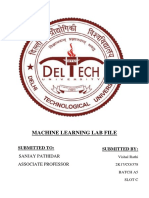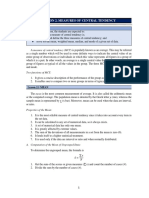0% found this document useful (0 votes)
12 views9 pagesML Lab Manual With Statistical Formulas
The document outlines a series of experiments aimed at installing Python and essential libraries for machine learning, performing mathematical operations with NumPy, and using Pandas for CSV file handling. It includes procedures for statistical calculations and visualizations using Matplotlib. Each experiment provides code examples and expected outputs to verify successful execution.
Uploaded by
19057cme009Copyright
© © All Rights Reserved
We take content rights seriously. If you suspect this is your content, claim it here.
Available Formats
Download as PDF, TXT or read online on Scribd
0% found this document useful (0 votes)
12 views9 pagesML Lab Manual With Statistical Formulas
The document outlines a series of experiments aimed at installing Python and essential libraries for machine learning, performing mathematical operations with NumPy, and using Pandas for CSV file handling. It includes procedures for statistical calculations and visualizations using Matplotlib. Each experiment provides code examples and expected outputs to verify successful execution.
Uploaded by
19057cme009Copyright
© © All Rights Reserved
We take content rights seriously. If you suspect this is your content, claim it here.
Available Formats
Download as PDF, TXT or read online on Scribd
/ 9





































































































